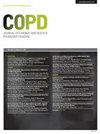肥胖对慢性阻塞性肺病患者呼吸困难的影响
IF 3.1
3区 医学
Q1 Medicine
International Journal of Chronic Obstructive Pulmonary Disease
Pub Date : 2024-07-22
DOI:10.2147/copd.s450366
引用次数: 0
摘要
背景:肥胖对慢性阻塞性肺病(COPD)患者呼吸困难的影响尚不清楚。我们旨在根据慢性阻塞性肺病患者的体重指数(BMI)对其呼吸困难情况进行评估,并根据慢性阻塞性肺病的严重程度调查肥胖对呼吸困难的影响:连续纳入了 1207 名体重指数≥ 18.5 kg/m² 的慢性阻塞性肺病患者(男性占 63%,支气管扩张剂后 1 秒用力呼气容积(BD 后 FEV1)的中位数(四分位数间距)为 51(34- 66)%)。呼吸困难采用 mMRC(改良医学研究委员会)量表进行评估。记录肺功能测试结果,并通过 CT 扫描(计算机断层扫描)对肺气肿进行量化:25%的患者为肥胖(体重指数≥ 30kg/m²),66%的患者有致残性呼吸困难(mMRC ≥ 2)。体重指数不同,mMRC 评分也不同(正常体重为 2 (1- 3),超重为 2 (1- 3) 1,肥胖患者为 2 (1- 3);P = 0.71)。mMRC 评分增加(0- 1 对 2- 3 对 4)与 BD 后-FEV1 下降(p < 0.01)、静态肺过度充气(吸气量/总肺活量 (IC/TLC))增加、DLCO 下降(p < 0.01)和肺气肿评分增加(p < 0.01)有关。与非肥胖患者相比,肥胖患者的静态肺过度充气程度降低(IC/TLC p < 0.01),肺气肿评分降低(p < 0.01)。非肥胖患者的 mMRC 评分随着 GOLD 分级(1- 2 对 3- 4)的增加而增加,但肥胖患者的 mMRC 评分没有增加,这与静态肺过度充气程度降低和肺气肿评分降低的趋势有关:与非肥胖患者相比,肥胖患者的呼吸困难并不随着肺活量测定 GOLD 分级的增加而增加。这可能是由于肥胖的机械效应导致肺过度充气减少,以及肥胖的严重慢性阻塞性肺疾病患者肺气肿程度较轻。本文章由计算机程序翻译,如有差异,请以英文原文为准。
Obesity Impact on Dyspnea in COPD Patients
Background: The role of obesity on dyspnea in chronic obstructive pulmonary disease (COPD) patients remains unclear. We aimed to provide an assessment of dyspnea in COPD patients according to their Body Mass Index (BMI) and to investigate the impact of obesity on dyspnea according to COPD severity.
Methods: One hundred and twenty seven COPD patients with BMI ≥ 18.5 kg/m² (63% male, median (interquartile range) post bronchodilator forced expiratory volume of 1 second (post BD FEV1) at 51 (34– 66) % pred) were consecutively included. Dyspnea was assessed by mMRC (Modified medical research council) scale. Lung function tests were recorded, and emphysema was quantified on CT-scan (computed tomography-scan).
Results: Twenty-five percent of the patients were obese (BMI ≥ 30kg/m²), 66% of patients experienced disabling dyspnea (mMRC ≥ 2). mMRC scores did not differ depending on BMI categories (2 (1– 3) for normal weight, 2 (1– 3) 1 for overweight and 2 (1– 3) for obese patients; p = 0.71). Increased mMRC scores (0– 1 versus 2– 3 versus 4) were associated with decreased post BD-FEV1 (p < 0.01), higher static lung hyperinflation (inspiratory capacity/total lung capacity (IC/TLC), p < 0.01), reduced DLCO (p < 0.01) and higher emphysema scores (p < 0.01). Obese patients had reduced static lung hyperinflation (IC/TLC p < 0.01) and lower emphysema scores (p < 0.01) than non-obese patients. mMRC score increased with GOLD grades (1– 2 versus 3– 4) in non-obese patients but not in obese patients, in association with a trend towards reduced static lung hyperinflation and lower emphysema scores.
Conclusion: By contrast with non-obese patients, dyspnea did not increase with spirometric GOLD grades in obese patients. This might be explained by a reduced lung hyperinflation related to the mechanical effects of obesity and a less severe emphysema in severe COPD patients with obesity.
Methods: One hundred and twenty seven COPD patients with BMI ≥ 18.5 kg/m² (63% male, median (interquartile range) post bronchodilator forced expiratory volume of 1 second (post BD FEV1) at 51 (34– 66) % pred) were consecutively included. Dyspnea was assessed by mMRC (Modified medical research council) scale. Lung function tests were recorded, and emphysema was quantified on CT-scan (computed tomography-scan).
Results: Twenty-five percent of the patients were obese (BMI ≥ 30kg/m²), 66% of patients experienced disabling dyspnea (mMRC ≥ 2). mMRC scores did not differ depending on BMI categories (2 (1– 3) for normal weight, 2 (1– 3) 1 for overweight and 2 (1– 3) for obese patients; p = 0.71). Increased mMRC scores (0– 1 versus 2– 3 versus 4) were associated with decreased post BD-FEV1 (p < 0.01), higher static lung hyperinflation (inspiratory capacity/total lung capacity (IC/TLC), p < 0.01), reduced DLCO (p < 0.01) and higher emphysema scores (p < 0.01). Obese patients had reduced static lung hyperinflation (IC/TLC p < 0.01) and lower emphysema scores (p < 0.01) than non-obese patients. mMRC score increased with GOLD grades (1– 2 versus 3– 4) in non-obese patients but not in obese patients, in association with a trend towards reduced static lung hyperinflation and lower emphysema scores.
Conclusion: By contrast with non-obese patients, dyspnea did not increase with spirometric GOLD grades in obese patients. This might be explained by a reduced lung hyperinflation related to the mechanical effects of obesity and a less severe emphysema in severe COPD patients with obesity.
求助全文
通过发布文献求助,成功后即可免费获取论文全文。
去求助
来源期刊

International Journal of Chronic Obstructive Pulmonary Disease
RESPIRATORY SYSTEM-
CiteScore
5.10
自引率
10.70%
发文量
372
审稿时长
16 weeks
期刊介绍:
An international, peer-reviewed journal of therapeutics and pharmacology focusing on concise rapid reporting of clinical studies and reviews in COPD. Special focus will be given to the pathophysiological processes underlying the disease, intervention programs, patient focused education, and self management protocols. This journal is directed at specialists and healthcare professionals
 求助内容:
求助内容: 应助结果提醒方式:
应助结果提醒方式:


